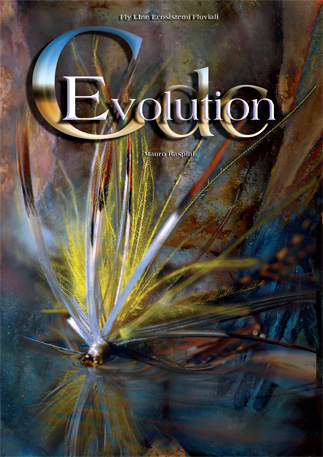
CDC Evolution – The discovery of the Cul de Canard has represented the greatest innovation to the art of dressings during the last few centuries and even millennia if we consider the fact that, since the birth of Fly fishing bird feathers, silk threads and animal pelts have been used. Indeed, no material has ever revolutionized this small world so much as this tiny feather. After the diffusion of flies built exclusively with Cul de Canard the light down started, like in the ‘Invasion of the Body Snatchers’, to progressively take over every known fly, traditional or of new conception. As one could have expected, people got carried away by enthusiasm and business schemes and the use of Cul de canard was greatley exaggerated. It was put everywhere, from salmon flies to wet flies, from the weighted nymphs to the streamers and so on. This has given birth to some interesting models as well as some abominable ones. In any case, all this experimentation has lead to the discovery of numerous tricks that allow us to use Cdc barbs to imitate every anatomical part of every invertebrate that can be eaten by fish. Indeed, this book presents all the devices, tricks and small instruments created to bend the soft, slippery, impalpable down and shape it to our liking. All of this with only one objective: making artificial flies more efficient. Much more efficient. Will it really be useful? Is it only fashion? Pure consumerism? Or is it a game to make dressings that have become boring more interesting? After all, insects haven’t evolved incredibly in the last hundred years or even in the last millennia… There are those who consider traditional flies obsolete, those who instead state that they have never been surpassed and that if there’s a problem it is that people aren’t able to interpret them well and most of all use them appropriately. However, while insects are still the same and evolution has not produced new species in this limited time frame, one thing has really changed: fish’s attitude towards insects, or rather towards the insect imitations which we sapiens produce. This is also evolution: fish adapt to changes in the environment and most of all they adapt to the traps we set them. Hence, it is necessary for us to reexamine the way in which we produce our deceptions. From this perspective, Mauro Raspini is a kind of evolutionist flytyer. Instead of studying the evolutionary transformations in the ethology of fish, he contributes to fuel such transformations. The title of this book is therefore perfect: Cdc Evolution.

Cet ouvrage propose 49 modèles extrêmement efficaces, issus des nouvelles typologies de construction, des nouveaux matériaux mais surtout de l’utilisation du cul de canard, présenté avec les systèmes de montage les plus sophistiqués.
La base de départ a été constituée à partir de 49 modèles classiques, choisis parmi les plus efficaces. Chaque mouche est illustrée par une séquence de photos haute résolution des différentes étapes de construction et par des explications.
Le cul de canard n’a été introduit que lorsqu’il s’harmonisait parfaitement avec la modèle classique de départ, dans le but d’améliorer son efficacité et la simplicité d’utilisation. Certains modèles sont construit uniquement en CDC.
Il nuovo libro “Cdc Evolution” di Mauro Raspini è pubblicato in tre edizioni nelle lingue: italiano, francese ed inglese. Quest’opera, edita da Fly Line, racconta tutto ciò che si è scoperto negli ultimi 5 lustri sul montaggio e sull’applicazione del cul de canard nelle mosche artificiali ove tale operazione ha un senso, vale a dire nei casi dove l’utilizzo del fantomatico piumino apporta vantaggi evidenti in termini di efficacia. Il libro presenta 49 artificiali, suddivisi per insetti imitati, capaci di sopperire a quasi tutte le esigenze del pescatore, trattandosi di uno spettro assai completo per ogni tipo di acque. La loro base è il modello classico, ma rivisto e riprogettato in funzione delle nuove tipologie costruttive (reverse, parachute, emerger, ecc), e di alcuni – pochi, ma veramente interessanti – nuovi materiali. Ma è il cul de canard il vero protagonista, poiché è stato applicato a tutti i modelli descritti in modo da renderli più funzionali, o più credibili, o più galleggianti o tutte le cose assieme. Il libro insegna a realizzare ogni dressing passo per passo, con foto ad alta risoluzione e spiegazioni semplici e chiare. Poi illustra tutti gli accorgimenti inventati per creare con le barbe del Cdc ogni struttura entomologica: ali, addomi, zampe, toraci, esuvie, elitre… Ma solo dove l’estrema idrofobicità del Cdc può essere sfruttata vantaggiosamente. Da anni i lettori lontani, non solo europei, dagli Usa alla Nuova Zelanda, dal Sudafrica al Sudamerica, che acquistano i libri di Fly Line e ne costruiscono i dressing illustrati sulla base delle fotografie e di quel poco di italiano che possono comprendere ci avvertono che nei loro paesi non dispongono di opere della nostra qualità e fantasia: ebbene, a breve potranno fruirne totalmente, a partire dalla nostra opera più significativa sull’utilizzo del fantomatico piumino che ha fatto impazzire il mondo dei flytyer.


